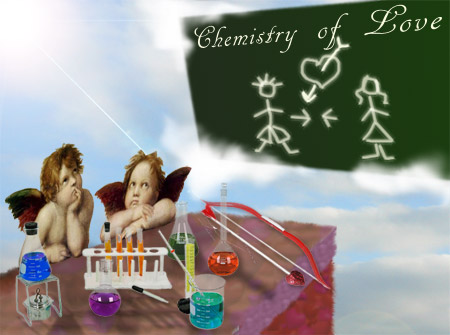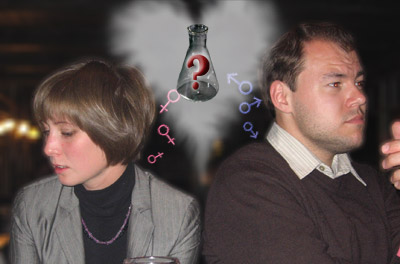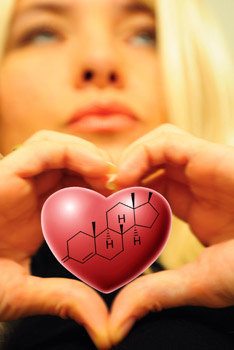Chemistry of Love
 Attraction, love and relationships are fueled by actual chemicals, well, who hasn't heard that line nowadays? So many different hypothesizes of the processes of falling in love and out of it were recently proposed and so many different candidates of chemicals named to be blamed that the subject gets more and more complicated. Let's try to pull all of them together and get a clear picture for to date, because with the modern level of science may be as soon as tomorrow another interesting piece of puzzle of the matter will be discovered.
Attraction, love and relationships are fueled by actual chemicals, well, who hasn't heard that line nowadays? So many different hypothesizes of the processes of falling in love and out of it were recently proposed and so many different candidates of chemicals named to be blamed that the subject gets more and more complicated. Let's try to pull all of them together and get a clear picture for to date, because with the modern level of science may be as soon as tomorrow another interesting piece of puzzle of the matter will be discovered.
First let's define what we are talking about, the term "chemicals" are by far too broad. Chemicals responsible for our behavior in love and relationships belong to the class of "neurochemicals", compounds forming largely in the brain and participating in neural activity. The brain, in its turn, passes them to other parts of the body, but "in the head" it all gets started.
First attraction, first "sparks" in the air followed by falling in love are caused by combination of three neurochemicals: phenylethylamine, norepinephrine and dopamine. Later stages of long relationships are guiding by another two: oxytocin and serotonin. That's our five candidates for today. Lets take a more close look on the first three:
Norepinephrine
 Norepinephrine, as is clear from its other name Noradrenaline, stimulates the production of adrenaline, which makes our heart race, and the palms sweat. Norepinephrine is getting released from neurons, or, simply, nerve cells in the brain, which are called noradrenergic neurons, of course.
Norepinephrine, as is clear from its other name Noradrenaline, stimulates the production of adrenaline, which makes our heart race, and the palms sweat. Norepinephrine is getting released from neurons, or, simply, nerve cells in the brain, which are called noradrenergic neurons, of course.
The noradrenergic neurons in the brain form a sort of system, which is, in its turn, called norepinephrine system, that, when activated, exerts effects on large areas of the brain [1]. By this action we can call it a neurotransmitter system, because its main function is the transmission of nerve impulse, which causes the other nerve to fire and pass the message along the "chain". The noradrenaline system consists of just 1500 neurons on each side of the brain, which is tiny compared to the total amount of more than 100 billion neurons in the brain. Nevertheless, when activated, the system plays major roles in the brain, Norepinephrine performs its actions on the target cells by binding to and activating its adrenergic receptors. The target cell expression of different types of receptors determines the ultimate cellular effect, and thus norepinephrine has different actions on different cell types. The main targets of the norepinephrine system to "ignite " are receptors in spinal cord, thalamus, phypothalamus, neocortex .etc.
High level of norepinephrine in the brain increases the experience of joy and reduces appetite [2], ever experienced that?
Dopamine
Dopamine is a neurochemical that is getting released by the brain when we feel good, for instance, by the influence of a good food [3] or reading a fascinating book. It also makes people more "talkative" and excitable. It affects brain processes that control emotional response, movement, ability to express pleasure, but also pain.
 Dopamine is very similar in structure to the norepinephrine, and is actually its precursor [4]. What does that mean? There will be no adrenaline produced, no sweating and heart racing if the brain can not produce enough dopamine first. The natural sources fordopamine are proteins from such sources as meat, nuts and egg whites, they are getting broken down by the digestive system into amino acids such as l-tyrosine, a precursor to dopamine. So, if you want to be more vulnerable, a vegetarian diet is not for you.
Dopamine is very similar in structure to the norepinephrine, and is actually its precursor [4]. What does that mean? There will be no adrenaline produced, no sweating and heart racing if the brain can not produce enough dopamine first. The natural sources fordopamine are proteins from such sources as meat, nuts and egg whites, they are getting broken down by the digestive system into amino acids such as l-tyrosine, a precursor to dopamine. So, if you want to be more vulnerable, a vegetarian diet is not for you.
Dopamine is the most mysterious of these three neurochemicals. Arvid Carlsson was awarded the 2000 Nobel Prize in Physiology or Medicine for showing that dopamine is not just a precursor of norepinephrine but a neurotransmitter, as well. This means that in addition to the norepinephrine system, there is also a dopamine neurotransmitter system. Briefly, dopamine makes us feel better and better by activating as many as five types of different receptors in the brain [5], which, of course, are called "dopamine receptors". Most of them are associated with the pleasure system of the brain, providing feelings of enjoyment and reinforcement to motivate a person proactively to perform certain activities.
Sociability is also closely tied to dopamine neurotransmission. Low dopamine receptor-binding is found in people with social anxiety. Traits common to negative schizophrenia (social withdrawal, apathy,) are thought to be related to a hypodopaminergic state in certain areas of the brain. A state of becoming hypersocial, is also credited to an increase in dopamine.
So, we can say, that dopamine has a dual role: it can act as a neuromodulator and a neurotransmitter. At the same time? Or one role is getting activated after another? Still a mystery. May be you will be the one to solve it?
Phenylethylamine
 The last but not the least is phenylethylamine (PEA), acts as a releasing agent of norepinephrine and dopamine [6]. The first attraction causes us to produce more PEA, which results in those dizzying feelings associated with romantic love. Large quantities of PEA increase both physical and emotional energy [7] and at the same time release more dopamine.
The last but not the least is phenylethylamine (PEA), acts as a releasing agent of norepinephrine and dopamine [6]. The first attraction causes us to produce more PEA, which results in those dizzying feelings associated with romantic love. Large quantities of PEA increase both physical and emotional energy [7] and at the same time release more dopamine.
PEA deserves a special attention because it is famous for being found in chocolate. You've probably heard that eating chocolate makes you feel good and even happy. And mostly, all sources are saying that it is because chocolate contains PEA [8].
Now you know that it is mostly dopamine which makes us feel good from the tasty food, and as far as PEA is concerned, it's role, unfortunately, has been exaggerated. Phenethylamine from chocolate is getting rapidly metabolized by the different enzymes of gastrointestinal tract, preventing significant concentrations from reaching the brain. So, when you eat chocolate, you feel good from a sweet taste, and not the concentration of PEA in it. In fact, phenylethylamine levels are higher in cheese and sausages [9], which are not associated with chemistry of love, well, at least by now.
Compare to the other two, PEA acts more as a neuromodulator rather than a neurotransmitter [10], [11]. While increasing the extracellular levels of dopamine, it also modulates noradrenergic transmission (as we have called the ignition of norepinephrine system). In other words, it would be fair to say, that PEA is more of a "helper" for bighting up the action of the previous two players. The mechanism for PEA "helping" is still not very clear, but most probably, when present in the brain, PEA is captured into the presynaptic vesicles and occupies the space normally taken by dopamine [12]. This leads to an increase in dopamine free-circulating, therefore enhancing dopaminergic transmission.
So, only when these three chemicals combine together, we feel the real "chemistry" of love. It is due to this combination that new lovers feel euphoric and energized and can talk days and nights long.
Acknowledgement

Content of the web page has been developed by Dina Kudasheva, Biologicals BV, The Netherlands. Photo by Natale & Dvight Hanson. Portion of the image is taken from Sistine Madonna by Raphael Sanzio
References
[1] Clinical Pharmacology, 10e, ISBN: 9780443102448, Published December 2007 Elsevier International.
[2] Elusive amines and primary headaches: historical background and prospectives. D'Andrea G, Terrazzino S, Fortin D, Cocco P, Balbi T, Leon A. Neurol Sci. 2003 May;24 Suppl 2:S65-7.
[3] Giuliano, F.; Allard J. (2001). "Dopamine and sexual function". Int J Impot Res 13 (Suppl 3): S18–S28.
[4] Rang, H. P. (2003). Pharmacology. Edinburgh: Churchill Livingstone. ISBN 0-443-07145-4.
[5] Structural and functional organization of the cerebral dopaminergic system; Barishpolets VV, Fedotova IuO, Sapronov NS. Eksp Klin Farmakol. 2009 May-Jun;72(3):44-9. Review. Russian.
[6] EM Parker.; LX Cubeddu (1988). "Comparative effects of amphetamine, phenylethylamine and related drugs on dopamine efflux, dopamine uptake and mazindol binding". Journal of Pharmacology and Experimental Therapeutics 245 (1): 199.
[7] Sabelli H, Javaid J. Phenylethlyamine modulation of affect: therapeutic and diagnostic implications. J Neuropsychiatry Clin Neurosci 1995;7:6-14.
[8] Liebowitz, Michael, R. (1983). The Chemistry of Love. Boston: Little, Brown, & Co
[9] HIGH PRESSURE LIQUID CHROMATOGRAPHIC ANALYSIS OF TYRAMINE, PHENYLETHYLAMINE AND TRYPTAMINE IN SAUSAGE, CHEESE AND CHOCOLATE" P. E. Koehler, R. R. Eitenmiller; Journal of Food Science,Volume 43, Issue 4 , Pages1245 - 1978 .
[10] A. Szabo, E. Billett, and J. Turner; Phenylethylamine, a possible link to the antidepressant effects of exercise? Br. J. Sports Med., October 1, 2001; 35(5): 342 - 343.
[11] Coffe, Tea ,Chocolate and the brain, Edd.Astrid Nehlig, p.209 2004 By CRC press LLC.
[12] Takefumi Miyazaki and Michael G Lacey. Presynaptic inhibition by dopamine of a discrete component of GABA release in rat substantia nigra pars reticulata. J Physiol. 1998 December 15; 513(Pt 3): 805-817.
More about chemistry of love on internet
- How Love works
- The Chemistry of Love @ Romancestuck.com
- What Is Chemistry in Love Relationships?
- The Physics and Chemistry of Love
- Cupid’s Chemistry
- Article Related to Romance, Dating and Relationships
